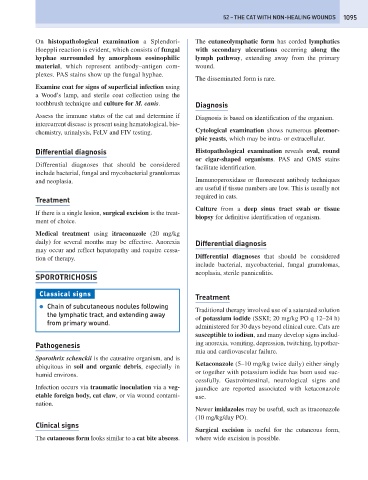Page 1103 - Problem-Based Feline Medicine
P. 1103
52 – THE CAT WITH NON-HEALING WOUNDS 1095
On histopathological examination a Splendori- The cutaneolymphatic form has corded lymphatics
Hoeppli reaction is evident, which consists of fungal with secondary ulcerations occurring along the
hyphae surrounded by amorphous eosinophilic lymph pathway, extending away from the primary
material, which represent antibody–antigen com- wound.
plexes. PAS stains show up the fungal hyphae.
The disseminated form is rare.
Examine coat for signs of superficial infection using
a Wood’s lamp, and sterile coat collection using the
toothbrush technique and culture for M. canis. Diagnosis
Assess the immune status of the cat and determine if Diagnosis is based on identification of the organism.
intercurrent disease is present using hematological, bio-
chemistry, urinalysis, FeLV and FIV testing. Cytological examination shows numerous pleomor-
phic yeasts, which may be intra- or extracellular.
Differential diagnosis Histopathological examination reveals oval, round
or cigar-shaped organisms. PAS and GMS stains
Differential diagnoses that should be considered
facilitate identification.
include bacterial, fungal and mycobacterial granulomas
and neoplasia. Immunoperoxidase or fluorescent antibody techniques
are useful if tissue numbers are low. This is usually not
required in cats.
Treatment
Culture from a deep sinus tract swab or tissue
If there is a single lesion, surgical excision is the treat-
biopsy for definitive identification of organism.
ment of choice.
Medical treatment using itraconazole (20 mg/kg
daily) for several months may be effective. Anorexia Differential diagnosis
may occur and reflect hepatopathy and require cessa-
tion of therapy. Differential diagnoses that should be considered
include bacterial, mycobacterial, fungal granulomas,
neoplasia, sterile panniculitis.
SPOROTRICHOSIS
Classical signs
Treatment
● Chain of subcutaneous nodules following
Traditional therapy involved use of a saturated solution
the lymphatic tract, and extending away
of potassium iodide (SSKI; 20 mg/kg PO q 12–24 h)
from primary wound.
administered for 30 days beyond clinical cure. Cats are
susceptible to iodism, and many develop signs includ-
Pathogenesis ing anorexia, vomiting, depression, twitching, hypother-
mia and cardiovascular failure.
Sporothrix schenckii is the causative organism, and is
Ketaconazole (5–10 mg/kg twice daily) either singly
ubiquitous in soil and organic debris, especially in
or together with potassium iodide has been used suc-
humid environs.
cessfully. Gastrointestinal, neurological signs and
Infection occurs via traumatic inoculation via a veg- jaundice are reported associated with ketaconazole
etable foreign body, cat claw, or via wound contami- use.
nation.
Newer imidazoles may be useful, such as itraconazole
(10 mg/kg/day PO).
Clinical signs
Surgical excision is useful for the cutaneous form,
The cutaneous form looks similar to a cat bite abscess. where wide excision is possible.

